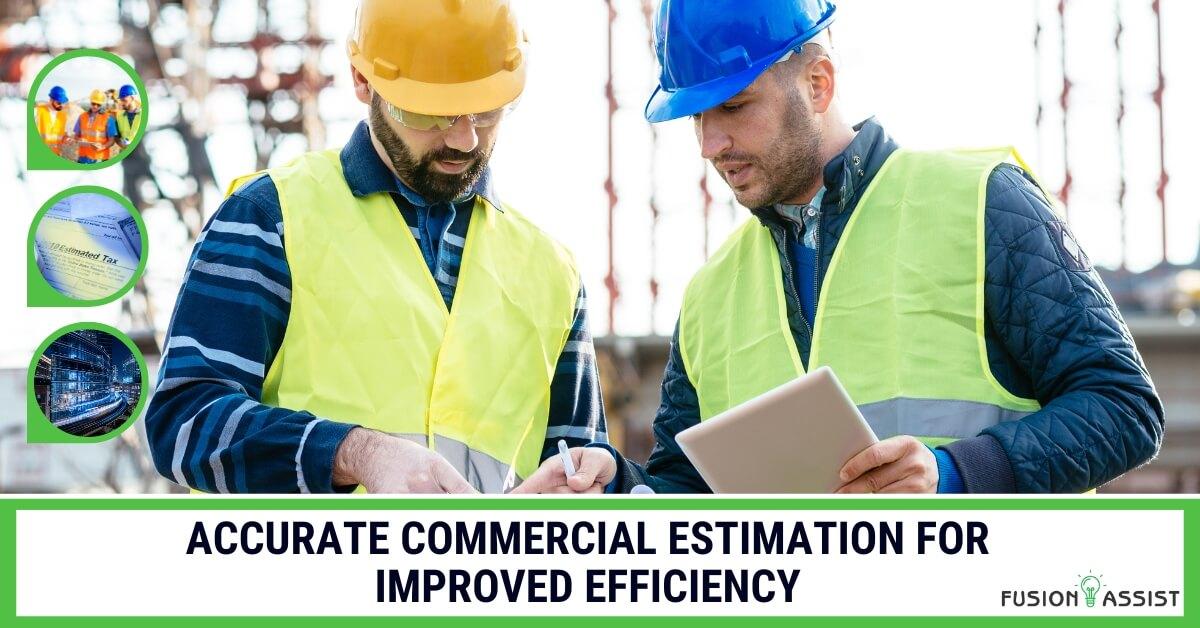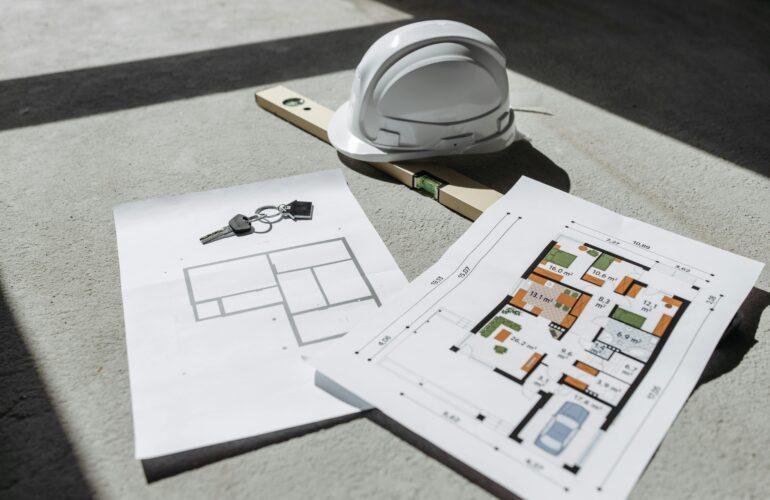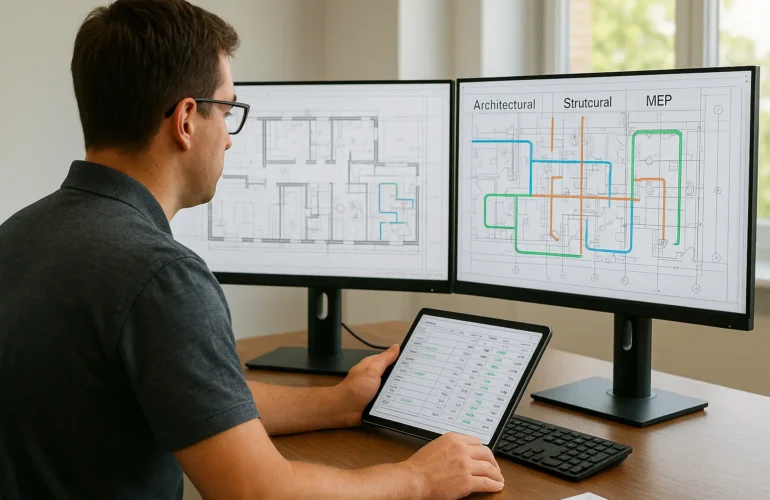Introduction
The fast-changing construction field relies on precise commercial estimation practices for complete project execution success. The budgets and schedules of new shopping mall development, industrial warehouse expansion, and commercial office renovation projects can suffer severe damage when estimation errors occur. Business efficiency relies on precise cost forecasting, the foundation for improvement efforts. Together, we will examine why commercial estimation matters, along with best practices to achieve accuracy, detailed industry examples, and crucial field knowledge, which enables developers, contractors, and property owners to succeed on their projects confidently.
What Is Commercial Estimation?
Forecasting everything needed to build a commercial construction project involves commercial estimation. The process requires detailed mathematical assessments of drawings, specifications, worker fees, material costs and rules, equipment prices, and danger assessments.
Commercial projects differ from residential ones due to multiple reasons, including:
- Larger scales and higher complexity
- Advanced mechanical, electrical, and plumbing (MEP) systems
- Strict regulatory compliance
- Specialised labour requirements
- Project documentation and contract management systems need to be extensive.
Minor errors/mistakes within commercial estimates produce significant financial challenges for businesses.
Why Is Accurate Commercial Estimation So Important?
Accurate project estimation determines how all project execution steps unfold.
- Budget Control: The budget control system maintains realistic financial plans to stop budget overruns.
- Efficient Resource Allocation: The system helps make good use of resources by properly distributing materials, equipment, and workforce.
- Client Confidence: Builds trust through transparency and reliability.
- Competitive Advantage: Enables more precise and successful bids.
- Risk Reduction: Risk Reduction features allow organizations to discover future threats before they become expensive problems.
Core Elements of a Commercial Estimate
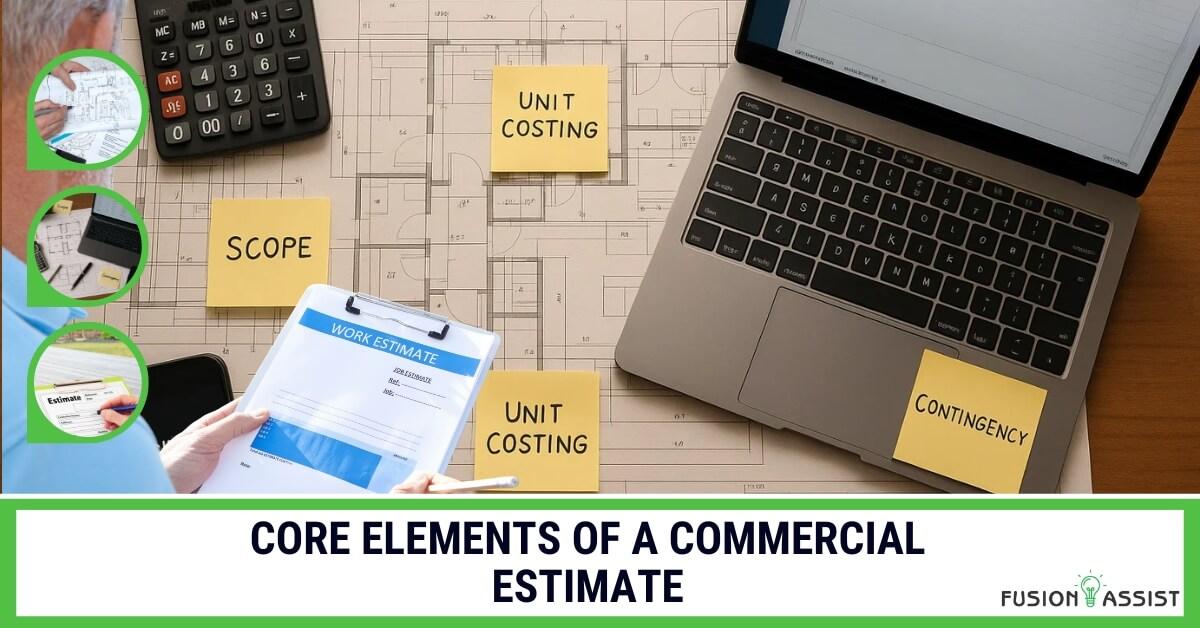
- Scope Definition: A Clear understanding of project parameters, objectives, and deliverables.
- Quantity Takeoff (QTO): Detailed measurement of all construction components.
- Unit Costing: The pricing approach employs present-day costs of labour, together with materials and subcontractor fees.
- Schedule Estimation: Project timelines will include realistic checkpoints for project milestones.
- Overhead and Profit Margin Calculation: When factoring in costs, organizations must incorporate general business expenses with their desired profit margin.
- Contingency Planning: Allowances for unforeseen circumstances.
- Permits and Compliance Costs: The budget must include the costs of zoning permits, safety codes, and environmental regulations.
Significant Challenges in Commercial Estimation
| Challenge | Impact | Solution |
|---|---|---|
| Incomplete Drawings | Miscalculations and delays | Require complete design sets before final estimate |
| Market Volatility | Material price fluctuations | Use escalation clauses and updated databases |
| Labor Shortages | Project slowdowns and higher costs | Forecast labour availability early |
| Scope Creep | Budget blowouts | Rigid change order management |
| Technological Gaps | Inefficiencies and errors | Invest in advanced estimating software |
The Impact of Poor Estimation: Industry Data
- Commercial projects encounter 73% of cost overruns because early project lifecycle estimations are low.
- Construction projects win more bids when pre-construction estimates reach an accurate level by 22%.
- BIM implementation reduces project estimate accuracy failures to levels reaching 32%.
Proven Strategies for Accurate Estimation
1. Collaboration
Since the beginning of projects, I have collaborated directly with architects, engineers, and consultants to establish precise scope definitions.
2. Database-Driven Costing
Tasks should be estimated using real-time price information and past project data contained in databases.
3. Third-Party Peer Reviews
Independent estimators should join the project for validation purposes while checking for errors.
4. Contingency Planning
Design changes, weather conditions, and supply chain interruptions require permanent cost provisions in all projects.
5. Continuous Learning
Your estimators need ongoing training that helps them predict industry codes, technology changes, and cost trends.
Latest Trends Impacting Commercial Estimation
1. AI and Machine Learning
Artificial intelligence conducts historical analysis to develop precise predictions about project cost forecasts.
2. BIM Integration (Building Information Modeling)
The 3d models generated by BIM technology provide instantaneous updates of material quantities to enhance QTOs.
3. Cloud-Based Estimation Tools
ProEst and Sage Estimating allow remote teams to collaborate immediately through their platforms.
4. Focus on Sustainability
Project costs must incorporate LEED certification, green materials, and energy efficiency standards.
How Technology Enhances Estimation Accuracy
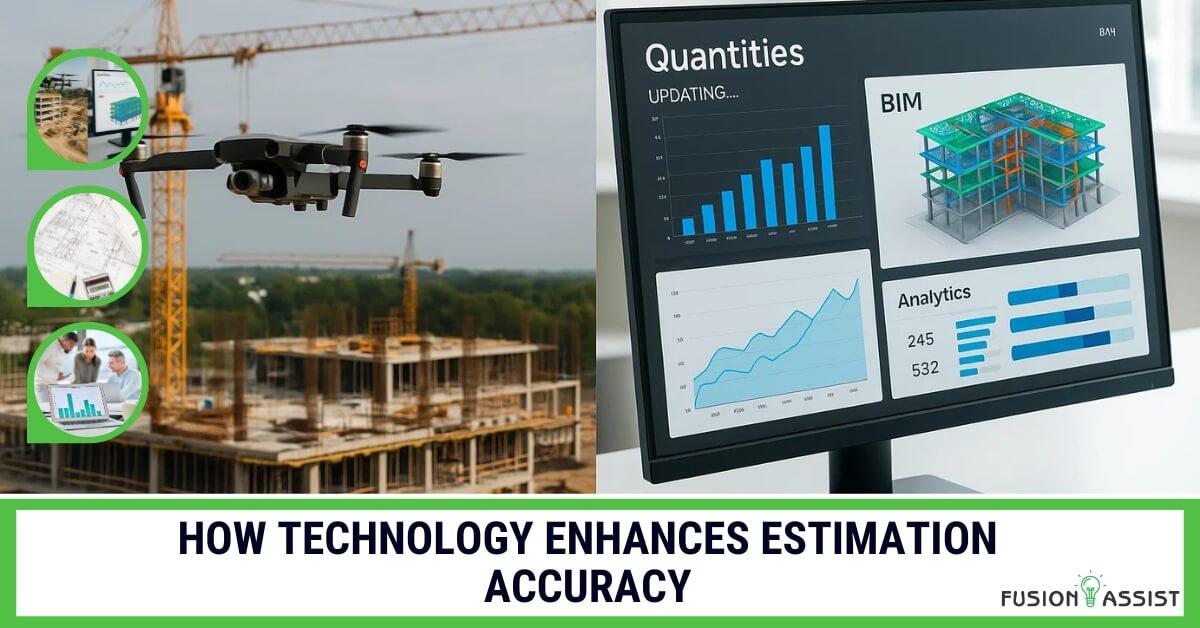
| Technology | Benefits |
|---|---|
| Estimating Software (e.g., ProEst, PlanSwift) | Faster takeoffs, centralized data |
| Drone Surveys | Accurate site analysis and earthwork volume calculations |
| Laser Scanning (LiDAR) | Precise measurement of existing conditions |
| AI-Based Forecasting Tools | Predict material shortages and cost escalations |
Case Studies by Fusion Assist
Case Study 1: Mixed-Use Development – New York City
Background
A major developer proposed building a Manhattan development consisting of retail stores on the first five floors, with residential units above twenty stories.
Challenge
When early planning began, details about higher union labour rates and the logistical complexities of building in a densely populated area were not included.
Solution
The team performed a new cost analysis based on union wages, crane rental fees, and delivery restrictions. We also integrated additional costs for protecting the protected waterway’s environment into our analysis.
Results
- The revised assessment increased by 18%, eliminating the potential for losing business due to underpricing.
- Realistic projection assumptions enabled the deal to secure financing worth $120 million.
- The project finished execution at a cost level that matched the original final projection by 1%.
Case Study 2: Healthcare Facility Expansion – Phoenix, AZ
Background
The healthcare provider required expanding their existing hospital by building a new 100,000 sq. ft. surgical wing.
Challenge
The project faced potential cost increases from unanticipated utility moves and complicated sterile environment standards.
Solution
The project used phased estimation as its approach.
- Conceptual budgeting during schematic design.
- Detailed re-estimates after design development.
- Final bid-stage review incorporating specialty subcontractor inputs.
Advanced laser scanning technology allowed staff to identify utility conflicts before construction started.
Results
- Change orders reduced by 42%.
- The project contingency funds were utilized at a rate of 4% instead of the expected 10%.
- The project finished three months earlier than expected, saving $750,000 for operational start-up expenses.
Conclusion
The accurate commercial estimation process involves more than arithmetic calculations because it requires complete comprehension of project execution systems. Building a link between vision and reality occurs by creating precise commercial estimates that consider site conditions alongside material prices while evaluating labor resources against client expectations.
The present market requires precise estimation, which includes:
- Winning better bids
- Building lasting client relationships
- Successful project completion occurs both within budget and within the scheduled deadline.
- Growing your business sustainably
At Fusion Assist, we blend leading-edge technology, deep industry expertise, and a commitment to detail, offering clients estimates that stand the test of time and complexity. If you’re ready to improve your project’s efficiency and bottom line, partner with a team that values accuracy as much as you do.
Let’s Build Better Together!
Contact Fusion Assist today for comprehensive commercial estimation services designed to ensure your project’s success from the very beginning.
FAQs
Q1. What is the biggest cause of cost overruns in commercial construction?
The main causes of cost overruns in commercial construction projects are scope modifications combined with incorrect assessments of soft costs, such as project permits, insurance premiums, and management expenses.
Q2. Should we hire a professional estimator or use software?
Both! While software provides time efficiencies, professional human estimators deliver the advantage of their expertise, risk assessment abilities, and judgment skills
Q3. What is a good contingency percentage for commercial projects?
A proper contingency percentage for commercial projects typically falls between 5% and 10%. Project risk levels determine the appropriate contingency amount, with healthcare and historic renovation projects needing between 12% and 15%.
Q4. How does location affect commercial estimates?
Urban development sites usually result in increased employee compensation, delivery complexities, and building permit expenses compared with suburban or rural construction efforts.
Q5. Can BIM modeling help estimators?
Absolutely. As design changes occur, updating project quantities dynamically through BIM becomes possible, resulting in precise and faster cost evaluation.

